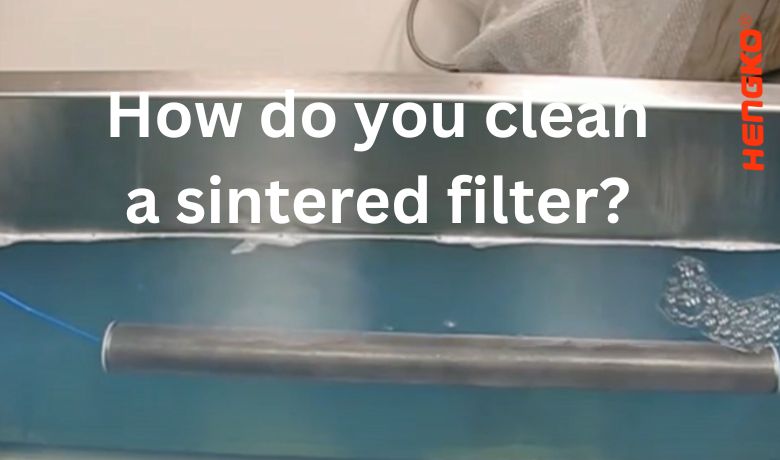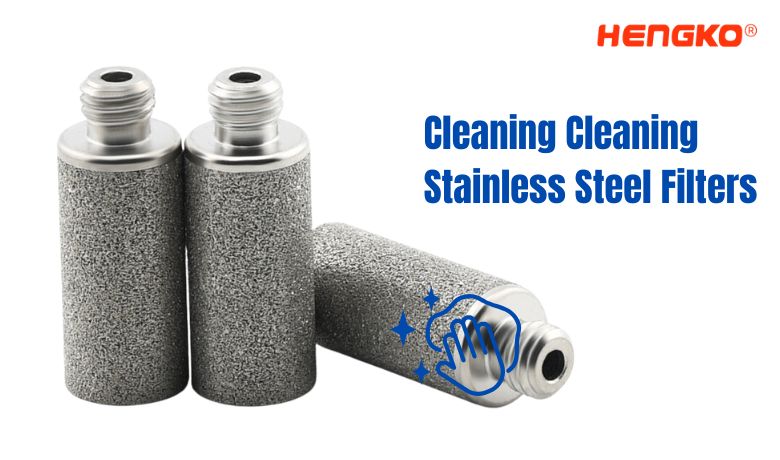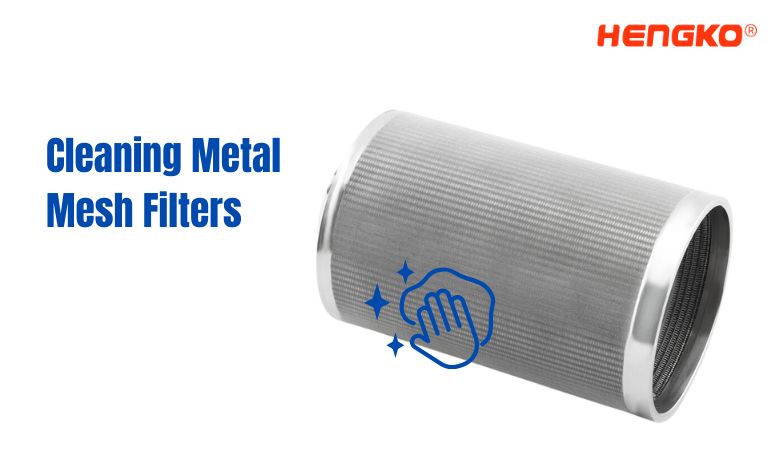As we know, Sintered metal filters are specialized filters made from metal powders that have been compacted
and processed at high temperatures to create a porous yet strong structure.
These filters are commonly used in various industries, including petrochemical, pharmaceutical, and food
and beverage, to separate particles from gases or liquids. Sintered metal filters are known for their durability,
high filtration efficiency, and ability to withstand extreme temperatures and pressures.
There are various types of sintered metal filters, and not all of them can be cleaned using the same method.
To extend the lifespan of these filters, it's important to use the appropriate cleaning technique for each type.
Let's explore the cleaning methods for each one now.

1. Types of Sintered Metal Filters
There are several types of sintered metal filters available in the market, each designed to meet specific filtration
requirements. The most common types of sintered metal filters include:
1. Stainless Steel Filters:
These filters are made from stainless steel powders and are widely used for their corrosion resistance, strength, and durability.
2. Bronze Filters:
These filters are made from bronze powders and are commonly used in applications where corrosion resistance is not a primary concern.
3. Metal Mesh Filters:
These filters are made from woven or non-woven metal fibers and are commonly used in applications where high flow rates are required.
4. Sintered Stone Filters:
These filters are made from natural or synthetic stone powders and are commonly used in applications where chemical resistance is a primary concern.
Each type of sintered metal filter has its own specific cleaning requirements, which will be discussed in more detail in the following sections.
2. Cleaning Stainless Steel Filters
Cleaning stainless steel filters is essential to maintain their performance and extend their lifespan.
Here are the steps to clean a stainless steel filter:
1.) Remove the filter from the system and rinse it with water to remove any loose particles.
2.) Soak the filter in a cleaning solution suitable for stainless steel.
A solution of warm water and mild detergent can be used for general cleaning,
while a solution of vinegar and water can be used for removing mineral deposits.
3. ) Use a soft brush to scrub the filter gently. Be sure to clean all the crevices and folds in the filter media.
4.) Rinse the filter thoroughly with water to remove all traces of the cleaning solution.
5.) Dry the filter completely before reinstalling it in the system.
For stainless steel filter cartridges, the same cleaning procedure can be followed.
However, it's essential to inspect the cartridge for any signs of wear or damage before reinstalling it.

3. Cleaning Sintered Bronze Filters
Cleaning sintered bronze filters is similar to cleaning stainless steel filters, but there are some differences
in the cleaning agents that can be used.
Step to Steps to clean a sintered bronze filter:
1.) Remove the filter from the system and rinse it with water to remove any loose particles.
2.) Soak the filter in a cleaning solution suitable for bronze. A solution of warm water and mild detergent
can be used for general cleaning, while a solution of vinegar and water can be used for removing mineral deposits.
Do not use any cleaning agents that are corrosive to bronze.
3.) Use a soft brush to scrub the filter gently. Be sure to clean all the crevices and folds in the filter media.
4.) Rinse the filter thoroughly with water to remove all traces of the cleaning solution.
5.) Dry the filter completely before reinstalling it in the system.
It's essential to inspect the bronze filter for any signs of wear or damage before reinstalling it.
Any damaged filters should be replaced to ensure optimal performance.
4. Cleaning Metal Mesh Filters
Metal mesh filters are often used in applications that require high flow rates. Here are the steps to clean a metal mesh filter:
1.) Remove the filter from the system.
2.) Rinse the filter with water to remove any loose particles.
3.) Soak the filter in a cleaning solution suitable for the type of metal used in the filter.
For example, if the filter is made from stainless steel, use a cleaning solution suitable for stainless steel.
4.) Use a soft brush to scrub the filter gently, ensuring to clean all the crevices and folds in the filter media.
5.) Rinse the filter thoroughly with water to remove all traces of the cleaning solution.
6.) Dry the filter completely before reinstalling it in the system.

5. Cleaning Sintered Stone
Sintered stone filters are used in applications where chemical resistance is a primary concern. Here are the steps to clean a sintered stone filter:
1.) Remove the filter from the system.
2.) Rinse the filter with water to remove any loose particles.
3.) Soak the filter in a cleaning solution suitable for stone.
A solution of warm water and mild detergent can be used for general cleaning, while a solution of vinegar
and water can be used for removing mineral deposits. Do not use any cleaning agents that are corrosive to stone.
4.) Use a soft brush to scrub the filter gently, ensuring to clean all the crevices and folds in the filter media.
5.) Rinse the filter thoroughly with water to remove all traces of the cleaning solution.
6.) Dry the filter completely before reinstalling it in the system.
To remove stains from sintered stone, a stain remover suitable for stone can be used.
Apply the stain remover to the stained area and follow the manufacturer's instructions for use.
Sintered stone is generally easy to clean because of its non-porous nature.
However, it's essential to use the correct cleaning agents to avoid damaging the stone.
6. Cleaning Sediment Filters
Sediment filters are used to remove particulate matter from water. Over time, these filters can become clogged with sediment and need to be cleaned to maintain their performance. Here are the steps to clean a sediment filter:
1. ) Turn off the water supply and release any pressure in the system.
2. ) Remove the sediment filter from the housing.
3. ) Rinse the filter with water to remove any loose sediment.
4. ) Soak the filter in a cleaning solution suitable for the filter media.
For example, if the filter is made from polypropylene, use a cleaning solution suitable for polypropylene.
5. ) Use a soft brush to scrub the filter gently, ensuring to clean all the crevices and folds in the filter media.
6.) Rinse the filter thoroughly with water to remove all traces of the cleaning solution.
7. ) Dry the filter completely before reinstalling it in the housing.
8. ) Turn on the water supply and check for any leaks.
It is essential to inspect the sediment filter for any signs of wear or damage before reinstalling it.
Any damaged filters should be replaced to ensure optimal performance.
7. Cleaning Sintered Disk Filters
Sintered disk filters are used in applications that require high filtration efficiency. Here are the steps to clean a sintered disk filter:
1. Remove the filter from the system.
2. Rinse the filter with water to remove any loose particles.
3. Soak the filter in a cleaning solution suitable for the filter media. For example,
if the filter is made from stainless steel, use a cleaning solution suitable for stainless steel.
4. Use a soft brush to scrub the filter gently, ensuring to clean all the crevices and folds in the filter media.
5. Rinse the filter thoroughly with water to remove all traces of the cleaning solution.
6. Dry the filter completely before reinstalling it in the system.
It's essential to inspect the sintered disk filter for any signs of wear or damage before reinstalling it.
Any damaged filters should be replaced to ensure optimal performance.
8. Cleaning Multilayered Sintered Filter Cartridges
Multilayered sintered filter cartridges are widely used in demanding filtration applications such as chemical processing,
pharmaceuticals, food and beverage, and petrochemicals. These cartridges are constructed by laminating multiple layers
of sintered metal mesh or powder into a gradient structure, which offers exceptional dirt-holding capacity, uniform pore distribution,
and high mechanical strength under high temperatures and corrosive environments.
Due to their complex internal structure and deep filtration capability, cleaning multilayered sintered filters requires
more attention compared to single-layer or standard porous filters.
Recommended Cleaning Procedures:
1.Backflushing with Clean Air or Liquid
Use reverse flow (opposite to the filtration direction) of clean compressed air, nitrogen, or deionized water to dislodge trapped particles.
This step is crucial to remove the bulk of surface and near-surface contaminants.
2.Ultrasonic Cleaning
Immerse the cartridge in an ultrasonic bath with a suitable cleaning solvent
(e.g., diluted citric acid or alkaline solution depending on contaminant type).
Ultrasonic energy helps loosen particles embedded deep within the layered structure.
3.Chemical Soaking (Optional)
For stubborn residues such as polymers, grease, or scaling, soak the filter in a chemical solution
tailored to the contaminant type. Common choices include weak acids (like nitric or phosphoric acid)
or alkaline detergents.
4.High-Temperature Baking (If Applicable)
For filters used in organic-rich or carbon-prone environments, thermal cleaning in a controlled furnace
(350–450°C) can effectively burn off residual organics.
Ensure material compatibility before applying heat.
5.Final Rinse and Drying
After cleaning, thoroughly rinse the cartridge with deionized water and dry it using filtered air or an oven.
Ensure no cleaning agent residues remain before reuse.
Who is HENGKO
HENGKO is a leading manufacturer of sintered metal filters that are designed to meet the highest standards
of quality and performance. Our filters are made from high-grade metal powders that are compacted and processed
at high temperatures to create a porous yet strong structure.
The result is a filter that provides excellent filtration efficiency, high durability, and the ability to withstand extreme
temperatures and pressures.
Features of HENGKO's Sintered Metal Filters:
* High filtration efficiency
* Durable and robust construction
* Suitable for high-temperature and high-pressure applications
* Customizable pore sizes to meet specific filtration requirements
* Corrosion-resistant materials
So about questions of Clean sintered filter, If you have any further questions about cleaning sintered filters
or if you need assistance with choosing the right filter for your application, please feel free to contact us.
Our team of experts at HENGKO is always ready to help you find the perfect filtration solution for your needs.
Reach out to us by email at ka@hengko.com. We look forward to hearing from you soon!
Send your message to us:
Post time: Nov-02-2023




